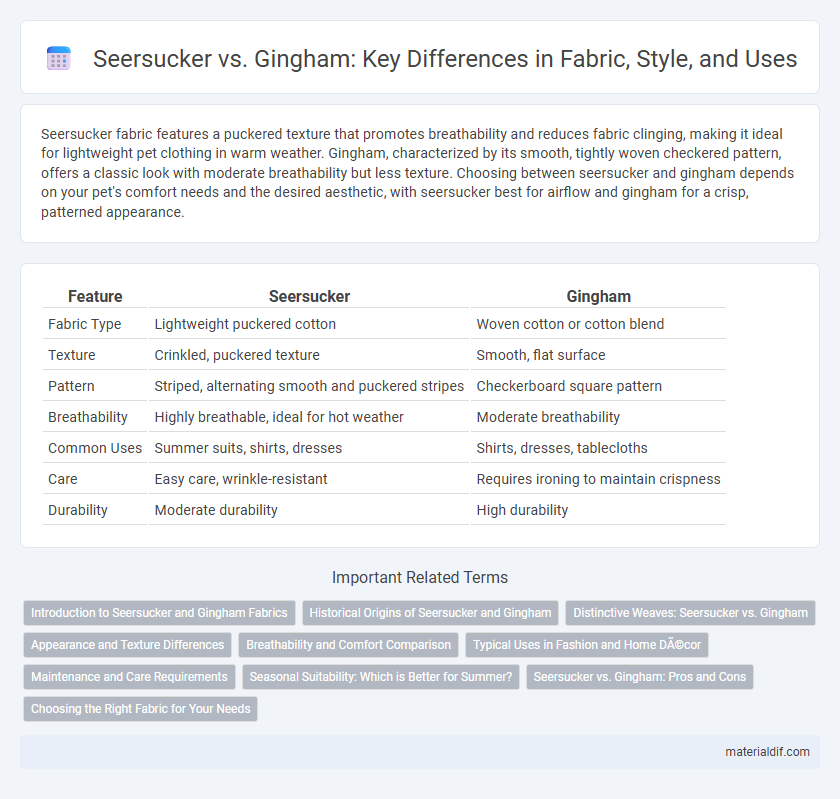Seersucker fabric features a puckered texture that promotes breathability and reduces fabric clinging, making it ideal for lightweight pet clothing in warm weather. Gingham, characterized by its smooth, tightly woven checkered pattern, offers a classic look with moderate breathability but less texture. Choosing between seersucker and gingham depends on your pet's comfort needs and the desired aesthetic, with seersucker best for airflow and gingham for a crisp, patterned appearance.
Table of Comparison
| Feature | Seersucker | Gingham |
|---|---|---|
| Fabric Type | Lightweight puckered cotton | Woven cotton or cotton blend |
| Texture | Crinkled, puckered texture | Smooth, flat surface |
| Pattern | Striped, alternating smooth and puckered stripes | Checkerboard square pattern |
| Breathability | Highly breathable, ideal for hot weather | Moderate breathability |
| Common Uses | Summer suits, shirts, dresses | Shirts, dresses, tablecloths |
| Care | Easy care, wrinkle-resistant | Requires ironing to maintain crispness |
| Durability | Moderate durability | High durability |
Introduction to Seersucker and Gingham Fabrics
Seersucker fabric features a puckered, textured surface created by weaving some threads tighter than others, resulting in a lightweight and breathable material ideal for warm weather clothing. Gingham is a smooth, woven cotton fabric characterized by its checkered pattern, typically made from dyed yarns in a balanced weave. Both fabrics are popular for casual and summer apparel due to their distinctive appearances and comfortable wear.
Historical Origins of Seersucker and Gingham
Seersucker fabric originated in the Indian subcontinent during the colonial period, characterized by its puckered texture designed to keep the fabric away from the skin, enhancing breathability in hot climates. Gingham fabric traces its roots to 17th-century Europe, initially produced as a striped fabric in the Dutch city of Groningen before evolving into the checkered pattern widely recognized today. Both fabrics gained popularity in the 19th and 20th centuries for their practicality and distinct visual appeal in casual and formal wear.
Distinctive Weaves: Seersucker vs. Gingham
Seersucker fabric features a puckered, crinkled texture achieved through a unique slack-tension weave that creates alternating smooth and bumpy stripes, enhancing breathability and comfort. In contrast, gingham showcases a classic plain weave with evenly spaced, checkered patterns formed by dyed yarns crossing at right angles, resulting in a smooth and lightweight fabric. These distinctive weaves define seersucker's textured surface and gingham's crisp check pattern, influencing their aesthetic and functional qualities in fashion and home textiles.
Appearance and Texture Differences
Seersucker fabric features a puckered, uneven texture created by weaving some yarns tighter than others, resulting in a wrinkled appearance that enhances breathability and reduces the need for ironing. Gingham, by contrast, is characterized by its smooth, flat weave and distinctive checked pattern formed by overlapping colored and white yarns, giving it a crisp, clean look. Seersucker's textured surface contrasts with gingham's sleek feel, making each fabric suitable for different styles and climate conditions.
Breathability and Comfort Comparison
Seersucker fabric features a puckered texture that enhances airflow, making it highly breathable and ideal for hot, humid climates. Gingham, a plain-woven cotton fabric, offers moderate breathability but lacks the textured surface that aids ventilation in seersucker. The puckered weave in seersucker minimizes fabric contact with the skin, increasing comfort by reducing sweat retention compared to the smoother, tighter weave of gingham.
Typical Uses in Fashion and Home Décor
Seersucker fabric is frequently used for lightweight summer clothing such as dresses, suits, and shirts due to its breathable puckered texture, making it ideal for warm weather fashion. Gingham fabric is popular in both apparel and home decor, often seen in shirts, dresses, tablecloths, and curtains because of its durable, smooth cotton weave and classic checkered pattern. Both fabrics bring distinct visual and textural qualities to interior design, with seersucker adding subtle dimensionality and gingham offering a clean, structured look.
Maintenance and Care Requirements
Seersucker fabric requires minimal maintenance due to its puckered texture that naturally resists wrinkles and hides stains, making it ideal for casual, low-effort care. Gingham, woven in a smooth cotton or cotton blend, tends to wrinkle more easily and demands regular ironing and gentle washing to preserve its crisp checkered pattern. Both fabrics benefit from cold water washes and air drying to extend their lifespan and maintain fabric integrity.
Seasonal Suitability: Which is Better for Summer?
Seersucker fabric, known for its puckered texture, excels in summer suit applications due to its breathability and ability to promote air circulation, making it ideal for hot and humid conditions. Gingham, while lightweight and breathable, has a smoother weave that may trap more heat compared to seersucker, thus slightly reducing its summer comfort. Choosing seersucker suits for warm weather ensures enhanced moisture-wicking and cooling properties, favoring superior seasonal suitability over gingham.
Seersucker vs. Gingham: Pros and Cons
Seersucker fabric is lightweight and breathable, ideal for hot weather, with a puckered texture that minimizes skin contact and reduces heat retention, while gingham features a smooth, tightly woven cotton texture with a classic checkered pattern offering durability and versatility for casual or formal wear. Seersucker resists wrinkles and requires minimal ironing, but its unique texture may limit styling options, whereas gingham offers a crisp appearance suitable for various garments but can crease more easily. Both fabrics excel in comfort and style, with seersucker favored for summer suits and gingham popular in shirts and dresses due to its easy care and traditional aesthetic.
Choosing the Right Fabric for Your Needs
Seersucker offers a lightweight, puckered texture that enhances breathability and is ideal for hot, humid climates, while gingham features a smooth, tightly woven cotton fabric with a crisp checkered pattern suitable for both casual and formal wear. Seersucker's natural puckering reduces direct fabric contact with skin, promoting airflow, whereas gingham provides a more structured appearance with durable cotton fibers. Selecting between seersucker and gingham depends on climate conditions and desired fabric feel, balancing comfort with style requirements.
Seersucker vs Gingham Infographic

 materialdif.com
materialdif.com